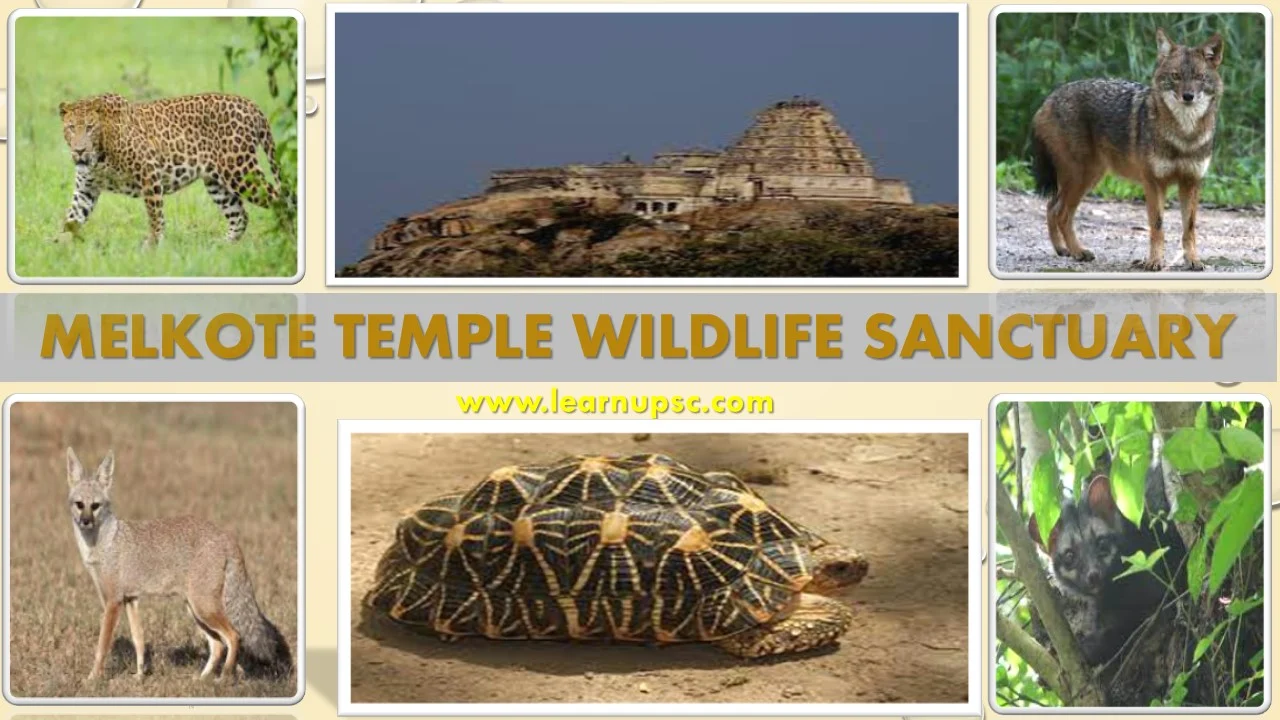Melkote Temple Wildlife Sanctuary UPSC
The Melkote Temple Wildlife Sanctuary is a protected area located in the state of Karnataka, India. This sanctuary is renowned for its ecological diversity and its role in conserving a variety of plant and animal species.
The sanctuary's location in the vicinity of Melkote, a village known for its temples and cultural heritage, adds to its significance, connecting natural conservation with historical and cultural aspects.
The sanctuary is home to a diverse range of flora and fauna, including over 130 species of birds, various mammals such as leopards, pangolins, and foxes, reptiles like star tortoises and sand boas, and a variety of trees and plants.
Visitors to the Melkote Temple Wildlife Sanctuary have the opportunity to experience and appreciate the beauty of nature while contributing to the efforts of preserving and protecting the area's unique flora and fauna.
|
Table of Contents
|
Melkote Temple Wildlife Sanctuary Location
The Melkote Temple Wildlife Sanctuary is located in the Mandya District of the state of Karnataka, India. It is situated about 5 km from the town of Melkote.
Melkote Temple Wildlife Sanctuary Nearest Airport:
The nearest airport to the Melkote Temple Wildlife Sanctuary is Mysore Airport, located about 60 km away.
Melkote Temple Wildlife Sanctuary Nearest Railway Station:
The nearest railway station to the sanctuary is Pandavapura Railway Station, situated around 25 km away.
Melkote Temple Wildlife Sanctuary History
The history of the Melkote Temple Wildlife Sanctuary is closely linked to the region's cultural, religious, and environmental significance.
Cultural and Religious Importance: Melkote is a historic village known for its religious and cultural heritage. The village houses significant temples, including the Cheluvanarayana Swamy Temple and the Yoganarasimha Temple. These temples have attracted devotees and pilgrims for centuries, contributing to the cultural fabric of the region.
Ancient Settlement: The village of Melkote has a history dating back centuries. It has been mentioned in various historical and mythological accounts by different names, such as Narayanadri, Vedadri, Yadavadri, Yathishaila, and Tirunarayanapura.
Establishment: The establishment of the Melkote Temple Wildlife Sanctuary dates back to 1974 when it was officially designated as a protected area for conserving the diverse flora and fauna of the region. The sanctuary covers a substantial area and is home to various species of birds, mammals, reptiles, and trees, as highlighted in the provided text.
Melkote Temple Wildlife Sanctuary Area
The Melkote Temple Wildlife Sanctuary covers an area of approximately 49.82 square kilometers. This expanse of land is designated as a protected area to conserve and safeguard the diverse range of flora and fauna found within the sanctuary's boundaries.
The sanctuary's relatively large area contributes to creating a suitable habitat for various species of birds, mammals, reptiles, and trees, as mentioned in the provided information.
Melkote Temple Wildlife Sanctuary Flora
The Melkote Temple Wildlife Sanctuary is home to a diverse range of flora (Dry Deciduous Scrub and Southern Thorn Forest), contributing to its ecological richness. Here are some examples of flora that are found within the sanctuary:
- Custard Apple
- Jackfruit
- Ficus
- Jamun
Melkote Temple Wildlife Sanctuary Fauna (Melkote Temple Wildlife Sanctuary Animals)
The Melkote Temple Wildlife Sanctuary is known for its diverse fauna, including various species of birds, mammals, reptiles, and other animals. Here are some examples of fauna that are found within the sanctuary:
Mammals:
- Leopard
- Pangolin
- Porcupine
- Indian Fox
- Golden Jackal
- Jungle Cat
- Asian Palm Civet
Birds:
With over 130 species of birds in the sanctuary, there is likely a wide variety of avian species. Some examples include:
- Various species of eagles and hawks
- Peafowls
- Parakeets
- Woodpeckers
- Songbirds
Reptiles:
- Star Tortoise
- Sand Boa
Melkote Temple Wildlife Sanctuary UPSC Questions
Q. What is Melkote Temple Wildlife Sanctuary famous for?
A. The Melkote Temple Wildlife Sanctuary is famous for being a protected area that encompasses a diverse range of flora and fauna. Some of its notable features and aspects of fame include:
(i) Biodiversity: The sanctuary is known for its rich biodiversity, including numerous species of birds, mammals, reptiles, and trees. This diversity highlights its significance as a habitat for various forms of wildlife.
(ii) Bird Watching: With over 130 species of birds, the sanctuary is a popular destination for birdwatchers and enthusiasts. The diverse avian population makes it an attractive spot for observing and studying different bird species.
(iii) Conservation: As a designated wildlife sanctuary, it is famous for its role in conserving and protecting the region's natural habitats, thereby contributing to the preservation of numerous plant and animal species.
(iv) Ecological Importance: The sanctuary represents a unique ecosystem, including Dry Deciduous Scrub and Southern Thorn Forest habitats. These habitats are valuable for understanding ecosystem dynamics and for scientific research.
(v) Cultural Connection: Melkote itself is a historically significant village known for its temples and cultural heritage. The sanctuary's existence adds an ecological layer to the region's overall importance.


No comments:
Post a Comment